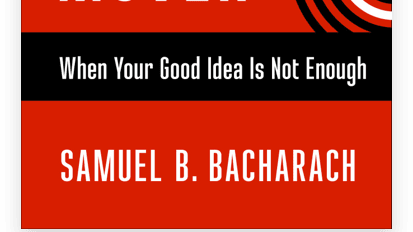Leadership is not just about ideas and vision. It's about getting things done. That's the message of The Agenda Mover: When Your Good Idea Is Not Enough (Cornell University Press, 2016) by Samuel B. Bacharach. The professor of organizational behavior at Cornell University says leaders must know where they want to go and whose support they will need to get there because when it comes to advancing your agenda, you can't do it alone. His book provides a practical four-step process that focuses on execution.
The key to being a successful agenda mover, according to Bacharach, is knowing how to anticipate, mobilize, negotiate and sustain:
Anticipate the agendas of others: Know where they're coming from. Agenda movers have the skills to analyze the agendas of others and anticipate arguments of resistance. Failed leaders, on the other hand, focus only on their own ideas. "The challenge is to be aware of how other people may receive your ideas and suggestions. In every setting, but especially in organizations, any action has implications that might not be immediately obvious," Bacharach writes. Effective leaders are aware of other people's intentions and aspirations and anticipate others' reactions before presenting their own plans.
Mobilize your campaign: Get initial support. After figuring out where people are coming from, agenda movers forge ahead to get initial support. Bacharach shows readers how to focus their message, justify their agenda, establish credibility and analyze how much support they want. "Mobilization is not a question of doing your homework or an exercise you do in your head or work out on paper," he explains. "You have to get into a coalition mind-set. You have to introduce your idea to a core of individuals who will rally around it with some sense of cohesion, purpose, and intent."
Negotiate support: Get the buy-in. After establishing initial support, effective leaders need to generate buy-in. "Getting the buy-in is a process of negotiation and persuasion. You must tap the motivation of allies, potential allies, and resistors. ... Any change, any innovation, no matter how positive it seems to you will inevitably raise angst in others. … After you reduce their fears and anxieties, you must focus on the fact that people are going to want to know what's in it for them. Show them the benefits," Bacharach writes.
Sustain your campaign: Get things done. Successful agenda movers may need to make adjustments, but they don't drop the ball. They are agile managers who sustain forward momentum. They know how to keep others on their side in order to go the distance. "You may have sold your idea and created a coalition, but you can only sustain momentum and get results if your team can keep up its energy and focus in spite of challenges, obstacles, and setbacks," Bacharach says. "This means you have to create traction, pivot to make adjustments, manage with agility, bolster the coalition mind-set, and remain politically astute."
In the final analysis, Bacharach concludes that "if you cannot move your agenda, you are not a leader."
Desda Moss is managing editor of HR Magazine.
Advertisement
An organization run by AI is not a futuristic concept. Such technology is already a part of many workplaces and will continue to shape the labor market and HR. Here's how employers and employees can successfully manage generative AI and other AI-powered systems.
Advertisement



